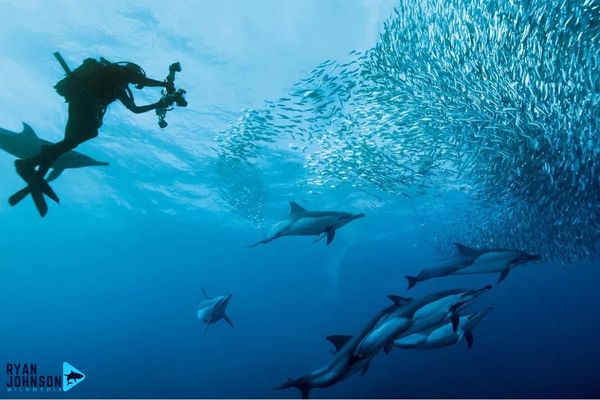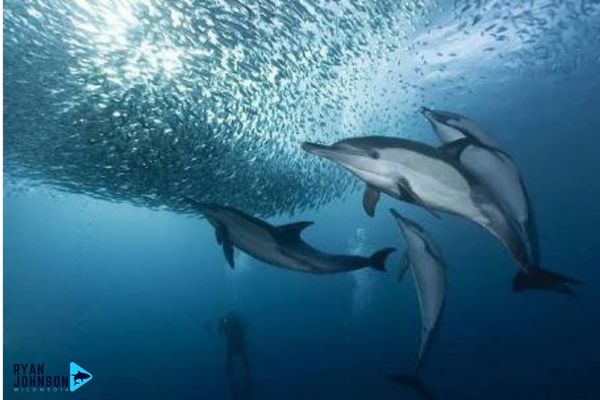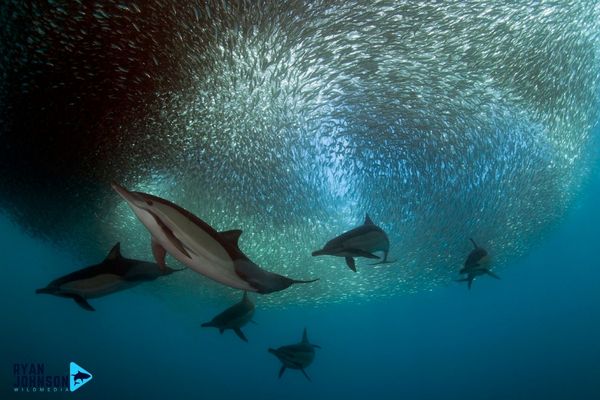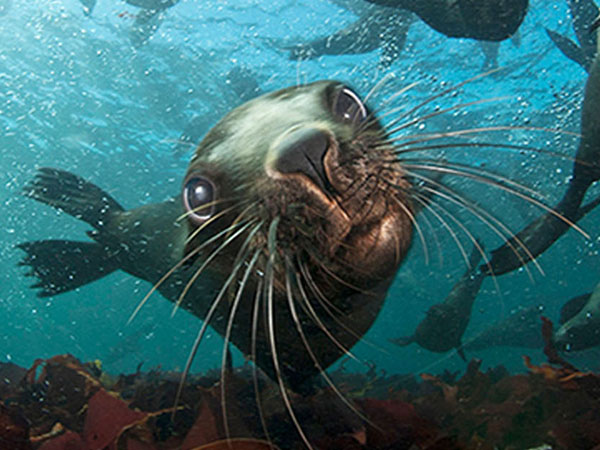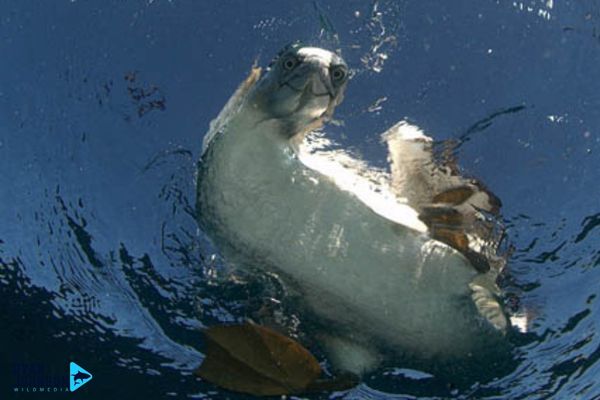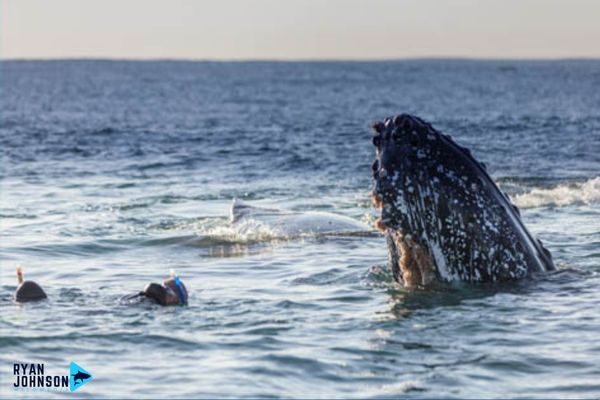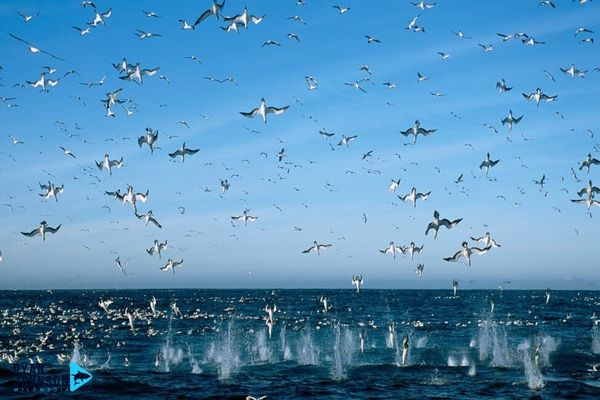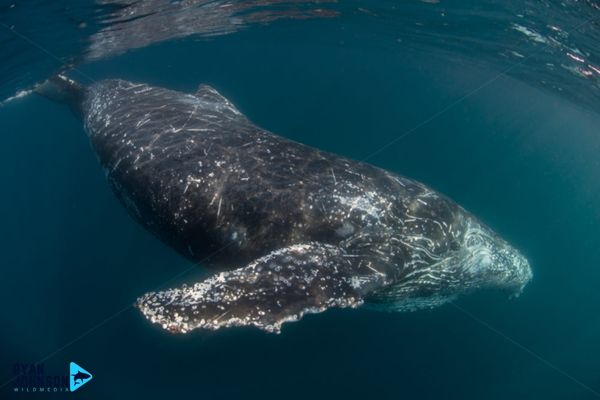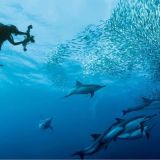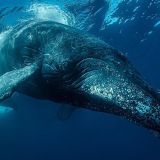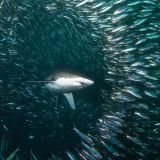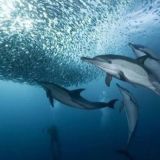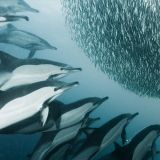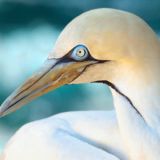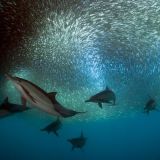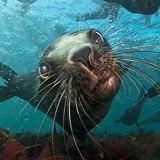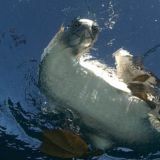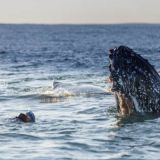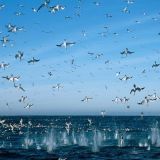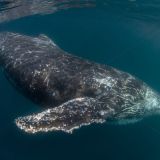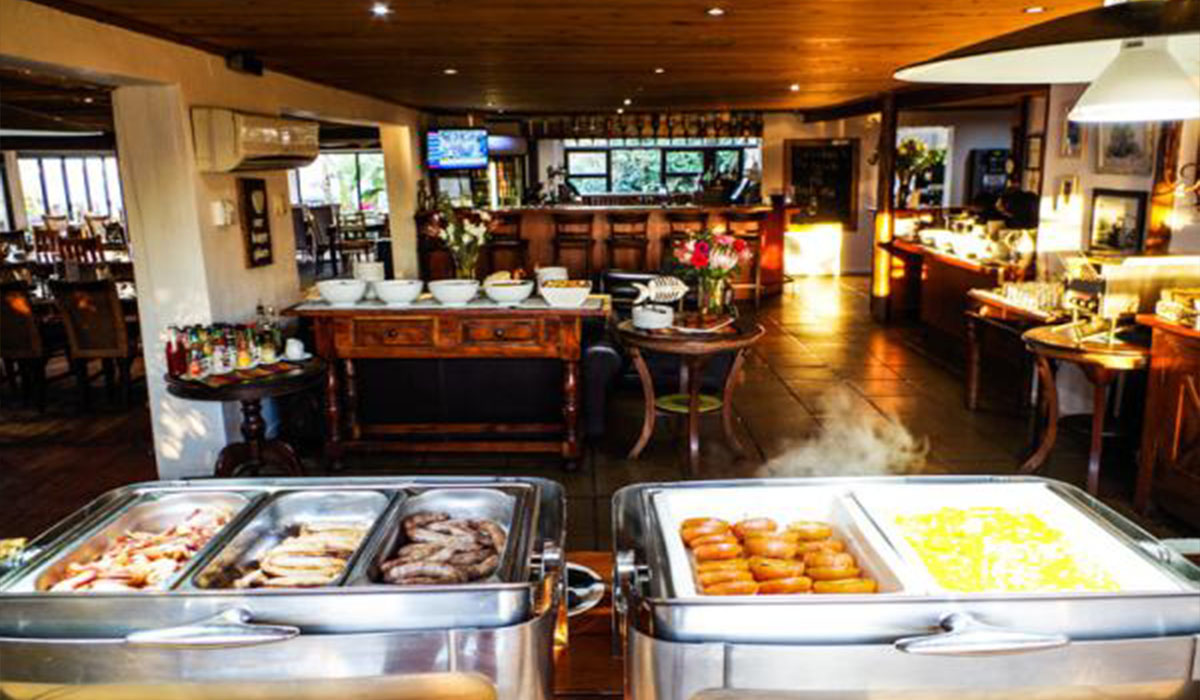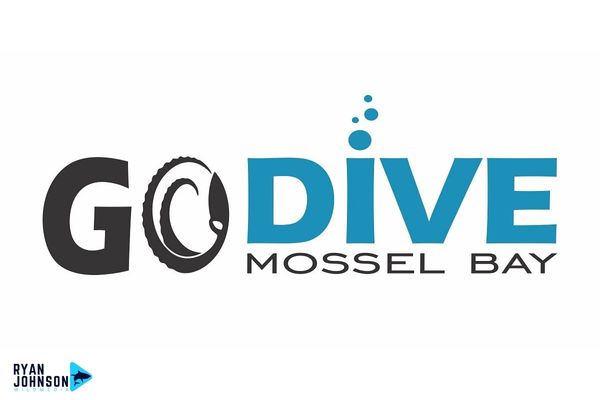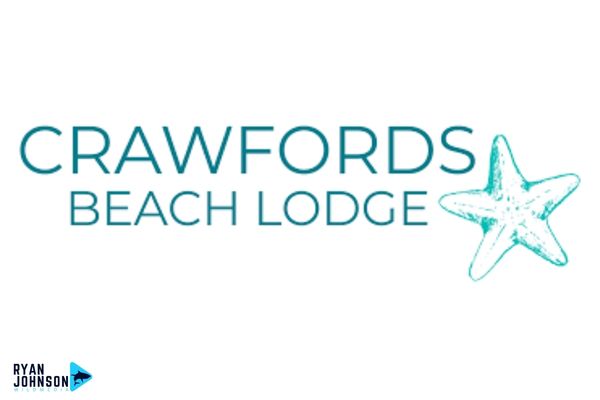Join me, Ryan Johnson — shark biologist and Shark Week presenter — on a once-in-a-lifetime expedition to witness one of nature’s most incredible spectacles: breaching great white sharks in Mossel Bay, South Africa. This region is the last place on Earth where great whites can still be reliably seen launching themselves clear out of the ocean in full-speed, high-impact breaches. I’ve spent years studying and filming these animals here, and I’m excited to share this unique opportunity with you.
Over the course of seven nights, we’ll head out on four early morning breaching expeditions, towing seal decoys across known hunting zones just after sunrise. These tours offer the best chance to see great whites explode from the water in breathtaking displays of power and predatory precision. We’ll also do four dedicated cage dives, giving you the rare opportunity to come face-to-face with great whites from the safety of a floating cage. Whether you’re a seasoned diver or first-timer, I’ll be with you every step of the way, offering insights into their behavior, biology, and conservation.
We’ll also take a day trip to the Robberg Peninsula near Plettenberg Bay. It’s one of my favorite places — not only for its stunning views and hiking paths, but for the chance to see great whites patrolling the massive Cape fur seal colony below. If we’re lucky, we might catch them engaging in some truly wild interactions with the seals. Another highlight is a scenic helicopter flight along the Mossel Bay coastline, where you’ll see sharks from above, gaining a rare perspective on how they move through the shallows and reefs. We’ll round things out with a classic African safari day, where we trade ocean for savanna and search for lions, elephants, rhinos, leopards, and buffalo in one of South Africa’s top wildlife reserves.
Our accommodation for the week is at Fly Me to the Moon Guesthouse, a comfortable and stylish retreat set in the peaceful countryside just ten minutes from our launch site. It’s the perfect place to unwind after a long day on the water. My team will take care of all the catering — breakfasts after breaching trips, packed lunches for our outings, and five dinners at the guesthouse, with two additional evenings spent at great local restaurants.
This expedition is more than just an adventure — it’s a deep dive into shark science and conservation. With small group sizes, there’s plenty of time for questions, photography, and meaningful encounters. If you’ve ever watched Shark Week and dreamed of being there in person, this is your chance. Come join me on the front lines of white shark research, where science, wildlife, and raw nature meet.
4 x Morning Breach Expeditions (2 hours each)
- Location: Mossel Bay
- Time: Sunrise departures
- Duration: Approx. 2 hours each
Experience the world’s most spectacular marine predation event: the breach. In the golden light of dawn, seal decoys are towed across known hunting routes of Mossel Bay’s great white sharks. With luck and patience, you’ll witness massive sharks launching from the deep in high-velocity aerial attacks — a heart-pounding spectacle usually only seen on Shark Week. Ryan Johnson and his team provide real-time commentary and insights into shark behavior, hunting strategies, and the importance of their conservation.
4 x White Shark Caging Expeditions (4 hours each)
- Location: Offshore from Mossel Bay
- Time: Late morning to afternoon
- Duration: Approx. 4 hours each
Come face-to-face with the ocean’s top predator in a way few ever do. Our cage dives allow guests to safely enter the water while white sharks cruise just feet away. These underwater encounters are powerful and awe-inspiring. Ryan and his team explain observed behaviors and answer questions, offering a deeper understanding of shark biology and ecology. The experience is open to both experienced divers and first-time participants.
1 x Robberg Peninsula Expedition – Plettenberg Bay (6 hours)
- Location: Robberg Nature Reserve, Plettenberg Bay
- Time: Early departure
- Duration: Approx. 6 hours
A scenic road trip takes us to the dramatic Robberg Peninsula, home to a vast Cape fur seal colony. Guests hike along coastal ridges with sweeping ocean views, looking down on one of South Africa’s richest marine predator-prey hotspots. On fortunate days, great whites can be seen patrolling the colony, occasionally chasing seals in dramatic displays of agility and strategy. The surrounding reserve also offers excellent photography opportunities.
1 x White Shark Helicopter Survey (1 hour)
- Location: Mossel Bay coastline
- Time: Scheduled based on weather conditions
- Duration: Approx. 1 hour
Board a private helicopter to conduct a scientific aerial survey of white shark movements along the Mossel Bay coast. This flight reveals the otherwise hidden world beneath the surface — with sharks often visible from the air as they cruise the reefs and shallows. Ryan shares his knowledge during the flight, explaining how aerial data supports long-term shark research and protection strategies.
1 x Elephant Walk (2 hours)
- Location: Indalu Private Game Reserve
- Duration: Approx.. 2 hours
Walk side by side with rescued African elephants in a safe and ethical environment. Accompanied by expert handlers and conservation staff, participants learn about the elephants’ individual stories, behavior, and social structure. This calm, grounded experience provides a deeply personal encounter with one of Africa’s most iconic and intelligent animals.
1 x Game Drive Safari (Half day)
- Location: Gondwana
- Duration: Approx. 4 to 5 hours
Explore the African bush on a professionally guided game drive in search of the Big Five: lion, leopard, elephant, rhino, and buffalo. This classic safari experience is complemented by sightings of giraffe, zebra, antelope, and a variety of birdlife. It’s a land-based adventure that provides a broader appreciation of South Africa’s extraordinary wildlife and ecosystems.
Evenings: Fireside Talks and Photo Reviews
Each evening, guests gather for relaxed discussions and briefings with me. These sessions include photo and video reviews from the day’s activities, presentations on shark science and conservation, and opportunities to ask questions in an informal and inspiring setting. Evenings are enjoyed over delicious local cuisine, with stunning views.
Please note – additional weather-independent wildlife / cultural activities and expeditions will be added if weather does not permit the full quota of breaching and cage diving trips to be obtained. These activities include:
- Winetasting
- Horseback Safari
- Cultural Tours
Accommodation for this expedition will be at the beautifully appointed Fly Me to the Moon Guesthouse, offering relaxed luxury in a peaceful countryside setting just 10 minutes from our shark expedition launch site. Overlooking the rolling hills outside Mossel Bay, the guesthouse is the ideal retreat to unwind after a full day of ocean adventures. Guests will be accommodated in either private or shared rooms, each tastefully decorated and equipped for comfort.
All catering during the expedition is arranged by my team. Guests will enjoy hearty breakfasts served after each morning breaching trip, convenient packed lunches for daily outings, and five dinners prepared at the guesthouse. On two evenings, we’ll dine at handpicked local restaurants to enjoy some of the region’s best cuisine and atmosphere.
Accommodation
-
All accommodation at Crawfords Beach Lodge, either shared or single depending on your booking
-
Comfortable, ocean-view rooms located just 50 meters from our daily boat launch site
Meals
-
All meals are included: daily breakfasts, lunches, and dinners
-
Hot drinks and snacks provided during activities and upon return
-
Please note: bar and alcoholic beverages are not included
Ocean-Based Activities
-
Daily Sardine Run expeditions (weather permitting) by zodiac
-
Snorkeling and/or scuba diving based on baitball conditions
-
Full scuba/snorkel gear provided: wetsuit, BCD, regulator, fins, mask, tanks, and weights
(You are welcome to bring your own equipment if preferred)
Photography and Videography Support
-
Expert guidance from me on capturing marine wildlife, both topside and underwater
-
Group and one-on-one feedback sessions
-
Daily reviews to help improve your imagery and storytelling
Transport and Transfers
-
Return transfers from King Phalo Airport (East London) to Crawfords Beach Lodge
-
All in-trip transport for scheduled activities
Permits and Entry Fees
-
All necessary marine permits and access fees
-
Conservation and launch site fees
Expert Leadership and Learning
-
Full-time leadership and guidance from me throughout the expedition
-
Daily educational briefings on ocean dynamics, Sardine Run behavior, and safety
-
Safety briefings and first aid equipment always available
International Flights
-
Airfare to and from King Phalo Airport, East London, South Africa
Travel Insurance (Required)
-
Comprehensive travel and medical insurance covering:
-
Emergency evacuation
-
Trip cancellations
-
Medical treatment
-
Loss or theft of personal items
-
Personal Gear
-
Cameras, SD cards, underwater housings, external drives, and binoculars
-
Dive computers (if you prefer to use your own)
Alcohol and Speciality Beverages
-
Drinks from the bar or outside the guesthouse are not included
Optional Activities
-
Spa treatments or any excursions not listed on the official itinerary
Gratuities
-
Tips for local staff, guides, and support crew are at your discretion
Visa and Entry Fees
-
Entry visas or travel documentation (if required for travel to South Africa)
To ensure a world class expedition, I have partner with the following companies.
No! You absolutely do not need to be a SCUBA diver to enjoy the Sardine Run. In fact, most of the action takes place right at the surface, where baitballs of sardines are driven upward by predatory fish, dolphins, and birds. This means that 90% of your time in the water will be spent snorkelling or freediving, allowing you to witness the incredible feeding frenzy up close without needing to go deep. We do have SCUBA gear available for certified divers who wish to use it, but rest assured—whether you’re on snorkel or SCUBA, your Sardine Run experience will be nothing short of spectacular.
It’s important that anyone considering joining me on the Sardine Run understands the true nature of this expedition. The Sardine Run is a completely wild and natural event—one of the last great ocean spectacles left on Earth. We don’t chum the water, manipulate marine life, or interfere in any way. Instead, we meet nature entirely on its own terms.
While we’ll be in the best possible location, at the best possible time, with the best possible team, I cannot guarantee that you’ll snorkel or dive on an active baitball. These events are unpredictable and often fleeting. That said, every single expedition I’ve led has been filled with jaw-dropping marine encounters: common dolphins in their thousands, diving gannets, migrating humpback whales, cruising sharks, and the ever-shifting dance of ocean predators and prey.
So while baitball action cannot be guaranteed, unforgettable wildlife moments absolutely can.
There’s no sugar-coating it—the Sardine Run is physically demanding. If you’re thinking of joining me, you need to be prepared for long, full-on days. We spend up to 8 hours out at sea each day on a small zodiac, often in rough or choppy conditions, chasing fleeting baitballs and fast-moving predators. It’s raw, real ocean adventure.
The expedition takes place during South Africa’s winter, so mornings are cold, and the water isn’t exactly tropical—around 17°C. You’ll be jumping in and out of that cool water repeatedly, and over time, your core temperature will start to drop. A good wetsuit helps, but it’s part of the challenge. This is why I recommend that participants have some level of ocean experience and a moderate degree of physical strength.
That said, our base at Crawfords Beach Lodge provides warm, comfortable accommodation and great food, so you’ll have everything you need to recharge and recover each evening. It’s a wild ride, but for those up to it, it’s one of the most unforgettable experiences you can have in the ocean.
On the Sardine Run, we are truly out in the wild ocean. While we launch from the beach at Chintsa, the reality is that we’re often operating up to two hours away from our launch site. Once we’re out there, we’re out for the day—returning to shore midday just isn’t an option.
If you’re prone to seasickness, it’s essential to plan ahead. Prevention is far better than trying to manage symptoms once you’re already feeling unwell at sea. I strongly recommend taking proven seasickness medication before launch and following any other strategies that work for you – like staying hydrated, eating lightly in the morning, and avoiding alcohol the night before.
The ocean can be unpredictable, and I want you to have the best possible experience. A bit of preparation can make all the difference between a tough day and the adventure of a lifetime.
The Wild Coast earned its name for a reason—weather here can change quickly and unpredictably. Running Sardine Run expeditions in this environment means that bad weather is not just possible, it’s likely. In fact, it’s common to lose a day—or sometimes more—on each expedition due to rough sea conditions that make launching unsafe.
To help manage this, I always keep a ‘floating’ reserve day built into the itinerary. This gives us a little flexibility to make up for a lost day on the water if the conditions allow later in the week. If the weather keeps us grounded for more than one day, we’ll offer alternative land-based activities in the area—whether that’s exploring local wildlife, photography sessions, or simply enjoying the beautiful Wild Coast.
That said, I want to be upfront: I’m unable to offer refunds for days lost due to bad weather. This expedition is about embracing nature on its own terms, and sometimes that means waiting out the storm. But rest assured, even when the ocean doesn’t cooperate, the Wild Coast still has plenty of magic to offer.
Yes, absolutely—you’re more than welcome to bring your camera gear! That said, I want to give you a heads-up: the Sardine Run is fast-paced and dynamic. We spend a lot of time quickly getting in and out of the boat to follow the action, which means there’s not always time to carefully handle large or delicate equipment.
In my experience, compact action cameras like GoPros often deliver the most rewarding footage and images simply because they’re easy to grab and go when things are happening fast. They let you stay in the moment and still come away with epic memories.
That said, when we do get those magic moments—like a stable baitball or calm interaction—there’s nothing quite like a good DSLR or mirrorless camera for capturing stunning underwater shots. If you’re bringing bigger gear, just be prepared for the pace, and I’ll do everything I can to help you make the most of those golden opportunities.
The timing of the Sardine Run is closely tied to the natural dynamics of the sardine migration itself. The run typically begins in April around the Port Elizabeth area and then gradually moves eastwards along the Wild Coast over the course of about three months.
Because of Chintsa’s location on the Wild Coast, the prime window to catch the main migration passing by here is in late May and early June. Over the ten years I’ve been running Sardine Run expeditions, I’ve found that trips scheduled during this late May period consistently deliver the best sightings and most incredible experiences year after year.
Many other operators offer trips in June and July, often launching from locations further east such as Port St. Johns. Since the sardine migration moves eastward, those areas tend to see the migratory pulses slightly later in the season. By aligning our expeditions with the peak timing for Chintsa’s stretch of coastline, we maximize our chances of being in the right place at the right time for the action.
After a decade of running Sardine Run expeditions, I’ve deliberately chosen Chintsa as our base, and for several good reasons that all come back to understanding the dynamics of the migration and the quality of the overall experience.
First, Chintsa gives us front-row seats to the early stages of the sardine migration. The shoals are at their largest and most intact here, as they’ve only just begun their journey from the colder southern waters. That means we often encounter giant, undisturbed shoals—and the predators haven’t yet carved them up the way they have further east. It’s a rare opportunity to witness the sardine run in its rawest, most spectacular form.
Second, because we’re operating earlier in the season—typically in May—the weather here is milder and more pleasant than later in the winter. We often enjoy warmer mornings and gentler conditions, which makes long days at sea a bit more comfortable.
And finally, and maybe most importantly for many of my guests: we get space. Only a couple of boats operate out of Chintsa during the sardine run, which means when we find a baitball, we’re often the only boat there—or maybe sharing it with just one other. Compare that to the more crowded sites like Port St. Johns, where a single baitball might attract five to ten boats packed with divers. For me, the quiet, respectful, and personal nature of the encounters at Chintsa is what makes the experience truly special.
So yes, it’s off the beaten path—but that’s exactly why I love it, and why I choose to share this part of the coast with you.
For the Sardine Run expedition, we shift our entire dive operation from Mossel Bay to Chintsa, where I’ve partnered with Crawfords Beach Lodge as our home base. This lodge is truly something special, and I’ve personally assessed it to ensure it offers the high standard of comfort and service that our guests deserve.
What started back in 1976 as a small piece of coastal farmland has grown into a remarkable family journey spanning three generations, culminating in what is now Crawfords Beach Lodge—the jewel of the Wild Coast. It’s not just the miles of pristine, near-deserted beach right at your doorstep, or the luxurious accommodation and delicious meals; it’s the unmistakable warm hospitality and peaceful atmosphere that will truly capture your heart.
In the immortal words of Old Man Roy, you’ll wake each day to spectacular sea views and magnificent surroundings, resting in rooms that offer everything you’d expect from a high-end beach resort. Whether you’re in one of the comfortable suites or rooms, you’ll find thoughtful amenities like air conditioning or fans, fully equipped kitchenettes, bar fridges, DSTV, and coffee and tea making facilities.
Our daily launch site is less than 50 meters from the lodge, so it’s incredibly convenient to step out and be on the water quickly each morning. After a full day chasing the sardines, Crawfords provides the perfect place to relax, recharge, and share stories with fellow adventurers around good food and friendly company. You’ll enjoy three delicious meals each day, served with care by the attentive staff.
I’m genuinely excited to welcome you to Crawfords Beach Lodge—it’s a place where your soul will find peace and your mind can fully recharge for the next day’s wild ocean adventure.
One of the real highlights of the Sardine Run—besides the ocean action—is the food! We’re based at Crawfords Beach Lodge, and they take excellent care of us when it comes to meals. Each morning kicks off with a hearty buffet breakfast to fuel us for the day ahead. In the evenings, we gather for delicious buffet-style dinners, often around a communal table and open fire. It’s a relaxed, social setting where stories are shared, photos are swapped, and friendships are built.
While we’re out at sea, I’ll make sure the boat is stocked with high-energy snacks and drinks to keep us going through long hours on the water.
Crawfords can cater for most dietary preferences, and if you have any specific requirements—vegan, gluten-free, allergies—just let me know ahead of time and we’ll make sure you’re looked after. Good food, good company, and incredible adventures—that’s the Sardine Run experience.
I totally understand that not everyone can commit to a full expedition, but the short answer is no, I don’t offer shorter versions of the trip.
I guide a maximum of two Sardine Run expeditions each year, and every group I take out becomes a close-knit team. We work together daily to track the action, share insights, and support each other both in and out of the water. Throughout the week, I provide hands-on guidance with videography, photography techniques, and help you understand the incredible dynamics behind the Sardine Run itself.
Allowing guests to come and go for shorter stays would disrupt that shared experience and the group dynamic I work hard to build. My priority is to give every participant a full, immersive adventure—so if you’re joining me, I want you there for the whole journey.
You’ll need to fly in and out of King Phalo Airport in East London, South Africa, which is the closest airport to our base at Crawfords Beach Lodge. It’s a small but well-connected airport with regular domestic flights from Johannesburg and Cape Town.
Once you land, it’s about a 45-minute drive to Crawfords—and I’ll be there to welcome you when you arrive at the lodge. From the moment you get in, I’ll make sure you’re looked after and ready for the adventure ahead.
Security note – If you are transiting and clearing customs at Johannesburg (O.R. Tambo) International Airport, please be aware that baggage security can be a concern. I strongly advise that all valuables — including cameras, underwater housings, and other electronics — be kept in your carry-on luggage whenever possible. If you must place any valuable items in your checked baggage, ensure your bags are securely locked and professionally plastic-wrapped before departure. Unfortunately, there have been frequent reports of theft from checked luggage by ground handling staff at Johannesburg airport, so taking these precautions is highly recommended.
Because I run a maximum of two exclusive Sardine Run expeditions each year, with a maximum of just eight participants per trip, it’s really important that everyone is certain about their commitment before booking. These small group sizes help me provide a personalized and unforgettable experience for everyone involved.
That said, deposits and payments are non-refundable. However, if you need to cancel at least two weeks before the expedition, I can transfer your deposit to a future year’s expedition—there will be a 5% administrative fee for this. This policy helps keep things fair and manageable on both sides, given the limited spaces and planning involved.
I appreciate your understanding and encourage anyone interested to be sure about their availability before confirming, so we can all focus on making the adventure incredible.
Yes, you do—and it’s really important. When you join me on the Sardine Run, you’ll be taking part in a physically demanding ocean-based adventure along South Africa’s Wild Coast. While we follow strict safety protocols and the chances of something going wrong are low, the reality is that we’re operating in the open ocean, where accidents can happen.
You’ll need to sign a liability waiver before the expedition begins, confirming that you understand the risks involved. I don’t provide insurance for injuries, illnesses, theft, or damaged gear, so it’s essential that you arrange your own comprehensive medical and travel insurance that covers you for diving, snorkeling, and ocean-based activities.
Make sure your policy covers you for your entire stay in Southern Africa—and if you’re bringing camera gear or other valuables, consider insuring those too. It’s all part of being well-prepared for the adventure.
Footwear
-
✅ Waterproof sandals (e.g. Crocs or Tevas)
-
✅ Warm socks
-
✅ Casual shoes for evenings
Swim & Dive Gear
-
✅ (Optional) Wetsuit (5mm recommended for snorkeling; 7mm or semi-dry for diving)
-
✅ Hooded vest / additional thermal layers (for added warmth)
-
✅ (Optional) Mask, snorkel, and fins
-
✅ Booties (thick-soled for walking and warmth)
-
✅ (Optional) Scuba gear (BCD, regulator, computer)
-
✅ Towel / poncho towel (quick-dry preferred)
Photography & Video Equipment
-
✅ Action camera (e.g. GoPro—ideal for quick water entries)
-
✅ DSLR / mirrorless camera with underwater housing (if you want high-end stills/video)
-
✅ Spare batteries and memory cards
-
✅ Dry bags / Pelican case (for protecting gear on boat)
-
✅ Microfiber cloths (for wiping lenses and screens)
-
✅ Lanyards / clips / floats (to secure your equipment)
Personal Items
-
✅ Sunscreen (reef safe)
-
✅ Lip balm with SPF
-
✅ Personal medications
-
✅ Sea sickness tablets or patches
-
✅ Reusable water bottle
-
✅ Daypack / backpack
-
✅ Travel adaptor (Type M/South Africa)
-
✅ Insurance documentation (medical & travel)
Optional but Recommended
-
✅ Laptop / hard drive (for backing up footage daily)
-
✅ Notebook / journal (to log sightings and shot notes)
-
✅ Binoculars (for topside action)
-
✅ Ear plugs / eye mask (for better sleep)
It can get cold and wet out there, so prioritize staying warm and dry. The better prepared you are, the more energy you’ll have to capture those once-in-a-lifetime sardine run moments!
Let me know if you’d like a printable checklist or gear rental recommendations in South Africa.




